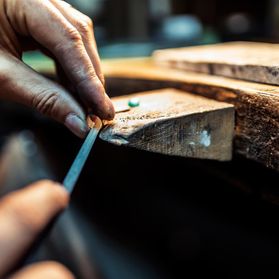Shop Now
- Warburtons Tool Kits
- 3D Jewellery CAD Software
- Benches, Tools & Accessories
- Books, DVDs & Templates
- Burs & Drills
- Casting & Melting
- Chains
- Cleaning
- Display
- Dust Extraction & Air Filtration
- FINDINGS - PEEKAYS
- Flex Shafts & Micromotors
- Forming
- Gemmological
- Gemstones
- Gift Voucher - Warburtons
- Jewellery Bead & Pearl
- Lapidary
- Lighting & Photography
- Magnifiers
- Mass Finishing
- Measuring: Gauges & Scales
- Metal: Sheet, Wire, Tube, Testing
- Microscopes
- Permanent Jewellery
- Plating, Colouring & Patinas
- Polishing & Abrasives
-
Presentation Packaging
- Carry Bags
- Carry Bags - Custom
- Deluxe Boxes
- Economy Jewellery Boxes
- Flock Boxes
- Imitation Leather
- Jewellery Pouches
-
Leatherette Jewellery Boxes
- Cufflink Box
- Gold Corner Earring Box
- Gold Corner Pendant Box
- Gold Corner Ring Box
- Gold Line Earring Box
- Gold Line Necklace Box
- Gold Line Pendant Box
- Gold Line Ring Box
- Leatherette Bangle Box
- Leatherette Bracelet Box
- Leatherette Double Ring Box
- Leatherette Earring Box
- Leatherette Long Bracelet Box
- Leatherette Multi Box
- Leatherette Necklace Box
- Leatherette Pendant Box
- Leatherette Ring Box
- Silver Corner Earring Box
- Silver Corner Pendant Box
- Silver Corner Ring Box
- Plastic Bags & Shipping Boxes
- Repair Envelopes
- Ribbon
- Supplementary Parts
- Wood Jewellery Boxes
- Clearance
- Safety
- Sandblasting
- Setting & Engraving
- Soldering & Welding
- Watchmakers
Warburtons Guide - How to Choose the Best Ultrasonic Cleaner for Your Workshop
Warburtons Guide - How to Choose the Best Ultrasonic Cleaner for Your Workshop
Why Every Jeweller Needs an Ultrasonic Cleaner
An ultrasonic cleaner is a must-have tool for jewellers, hobbyists, and professional workshops alike. These devices use high-frequency sound waves to create microscopic vibrating bubbles in a cleaning solution. When these bubbles collapse, they gently remove dirt, polishing residue, and grime, even from the tiniest crevices of intricate jewellery. Unlike manual cleaning, ultrasonic technology guarantees a thorough, professional finish every time.
But with so many options available, how do you pick the right ultrasonic cleaner for your needs? This guide walks you through the key factors, such as tank capacity, cleaning power, and advanced features, along with expert recommendations from Warburtons.
- Understand What You’re Cleaning
Start by considering the type and amount of jewellery you’ll be cleaning:
- For hobbyists or small studios: A compact ultrasonic cleaner, like the ELMA Easy 10H (0.8L) or Digi-Pro DH (2L), is perfect for rings, earrings, and smaller batches.
- For busy workshops: Opt for a larger model with a larger tank like the Elma Easy 30H (2.75) or Digi-Pro DH (4L). These are designed for high-frequency use and can handle bulk jewellery, ideal for professional jewellers.
- Tank Size & Capacity
The tank size determines both the number and size of items you can clean:
- 1–3L Tanks: Ideal for home jewellers or small studios.
- 3–5L Tanks: Great for bench jewellers handling multiple items at once.
- 5L+ Tanks: Perfect for large-scale workshops and cleaning watch parts in bulk.
Pro Tip: Always choose a tank that comfortably fits your most significant piece of jewellery.
- Cleaning Power & Frequency
Performance depends heavily on the cleaner’s frequency:
- 35–40 kHz: Standard and sufficient for most jewellery cleaning needs.
- 45 kHz+: Better for most gemstones or intricate, fine-detail jewellery.
- Adjustable Frequency Models: Provide flexibility for various materials, from sturdy metals to softer stones.
- Features Worth Investing In
Modern ultrasonic cleaners come with advanced features that enhance results:
- Heating Function: Warm solutions loosen dirt and residue faster.
- Digital Timers: Help control cleaning cycles to prevent over-cleaning delicate pieces.
- Degas Function: Eliminates trapped air in the solution, boosting cleaning efficiency.
- Sweep Function: Sweeps output frequency, eliminating “dead spots” in the tank
Recommendation: The ELMA Easy series and Digi-Pro SWD series combine most of these features, making them great professional options.
- Build Quality & Durability
An ultrasonic cleaner is an investment, so go for models with stainless steel tanks and solid construction. Cheaper plastic models may lack reliability and cleaning consistency.
- Top Ultrasonic Cleaners from Warburtons
Here are some trusted models to consider:
- ELMA Easy Series: Perfect for small to medium tasks.
- Digi-Pro DH: perfect for medium to larger tasks.
- Tips for Safe & Effective Use
- Use professional cleaning solutions designed specifically for ultrasonic machines to protect your jewellery.
- Avoid cleaning pearls, opals, or emeralds on high-power settings, as they can crack or lose their polish. Tip: Ionic Cleaners are best for these delicate items
- Regularly replace your cleaning solution for consistent performance.
Explore New Zealand's Leading Range of Ultrasonic Cleaners
Ready to elevate your jewellery cleaning game? Warburtons offers one of the most comprehensive ranges of ultrasonic cleaners in New Zealand, catering to both hobbyists and professionals.
FAQs
- Can I use tap water in an ultrasonic cleaner?
Yes, but adding a recommended cleaning solution will give better results.
- How long should I run the machine?
Most jewellery only needs 3–5 minutes. For delicate items, use shorter intervals.
- Is every gemstone safe to clean ultrasonically?
No. Avoid soft or porous stones like pearls, opals, and emeralds.
- What’s the best frequency for jewellery cleaning?
35–45 kHz works for most pieces. Higher frequencies suit delicate gems.
- How often should I change the cleaning solution?
Replace it once it looks dirty or after a few cycles.
- How long does an ultrasonic cleaner last?
With regular maintenance, high-quality models can last 5–10 years or more.
- Can I add hot water to my ultrasonic tank?
While warm or hot water may improve the cleaning process, pouring hot water into the tank can cause damage to the unit. Therefore, it is best to let the ultrasonic device heat the water itself.
Conclusion
The best choice of an ultrasonic cleaner depends on your jewellery volume, cleaning requirements, and desired features. Whether you’re a casual hobbyist or a professional jeweller, choosing a quality machine from Warburtons ensures every piece comes out sparkling and flawless.




